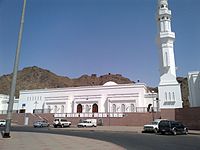
Back أثرية (عقيدة) Arabic Әҫәрилек Bashkir আসারি Bengali/Bangla Atharisme Catalan Athari German Teología tradicionalista (islam) Spanish Atharisme French Atsariyah ID അഥരി Malayalam Atharisme Dutch
| Part of a series on Sunni Islam |
|---|
 |
|
|
| Part of a series on:
Salafi movement |
|---|
 |
|
|
Atharism (Arabic: الأثرية, romanized: al-ʾAthariyya) is a school of theology in Sunni Islam which developed from circles of the Ahl al-Hadith, a group that rejected rationalistic theology in favor of strict textualism in interpretation the Quran and the hadith.
Adherents of Athari theology believe the zahir (literal) meaning of the Quran and the hadith are the sole authorities in matters of aqida and Islamic jurisprudence;[1] and that the use of rational disputation is forbidden, even if in verifying the truth.[2] Atharis oppose the use of metaphorical interpretation regarding the anthropomorphic descriptions and attributes of God (ta'wil) and do not attempt to conceptualize the meanings of the Quran rationally[3] since they believe that their realities should be consigned to God alone (tafwid).[4] In essence, they assert that the literal meaning of the Quran and the ḥadīth must be accepted without a "how" (i.e. "Bi-la kayfa").
Athari theology emerged among hadith scholars who eventually coalesced into a movement called Ahl al-Ḥadīth under the leadership of Ahmad ibn Hanbal (780–855). In matters of faith, they were pitted against Mu'tazilites and other theological Islamic currents and condemned many points of their doctrine as well as the extreme rationalistic methods they used.[5] In the 10th century, al-Ashʿarī and al-Māturīdī found a middle ground between Muʿtazilite rationalism and Hanbalite literalism, using the rationalistic methods championed by Muʿtazilites to defend most tenets of the Athari doctrine.[6] Although the mainly Hanbali scholars who rejected that synthesis were in the minority, their emotive, narrative-based approach to faith remained influential among the urban masses in some areas of the Muslim world, particularly in Abbasid Baghdad.
Ashʿarism and Māturīdism are often regarded as the creeds of Sunni "orthodoxy", but Athari theology has thrived alongside it by laying rival claims to be the orthodox Sunni faith.[7] In the modern era it has had a disproportionate impact on Islamic theology, having been appropriated by Wahhabi and other traditionalist Salafi currents, and spread well beyond the confines of the Hanbali school of jurisprudence.[8]
- ^ Abrahamov, Binyamin (2016) [2014]. "Part I: Islamic Theologies during the Formative and the Early Middle period – Scripturalist and Traditionalist Theology". In Schmidtke, Sabine (ed.). The Oxford Handbook of Islamic Theology. Oxford and New York: Oxford University Press. pp. 263–279. doi:10.1093/oxfordhb/9780199696703.013.025. ISBN 9780199696703. LCCN 2016935488.
- ^ Halverson (2010, p. 36).
- ^ Hoover, John (2020). "Early Mamlūk Ashʿarism against Ibn Taymiyya on the Nonliteral Reinterpretation (taʾwīl) of God's Attributes". In Shihadeh, Ayman; Thiele, Jan (eds.). Philosophical Theology in Islam: Later Ashʿarism East and West. Islamicate Intellectual History. Vol. 5. Leiden and Boston: Brill Publishers. pp. 195–230. doi:10.1163/9789004426610_009. ISBN 978-90-04-42661-0. ISSN 2212-8662. LCCN 2020008682. S2CID 219026357.
- ^ Halverson (2010, pp. 36–37).
- ^ Cite error: The named reference
Lapidus130was invoked but never defined (see the help page). - ^ Blankinship (2008, p. 53); Lapidus (2014, pp. 123–124)
- ^ Brown (2009, p. 180): "The Ash‘ari school of theology is often called the Sunni 'orthodoxy'. But the original ahl al-hadith, early Sunni creed from which Ash‘arism evolved has continued to thrive alongside it as a rival Sunni 'orthodoxy' as well."
- ^ Hoover (2014, p. 625)
© MMXXIII Rich X Search. We shall prevail. All rights reserved. Rich X Search